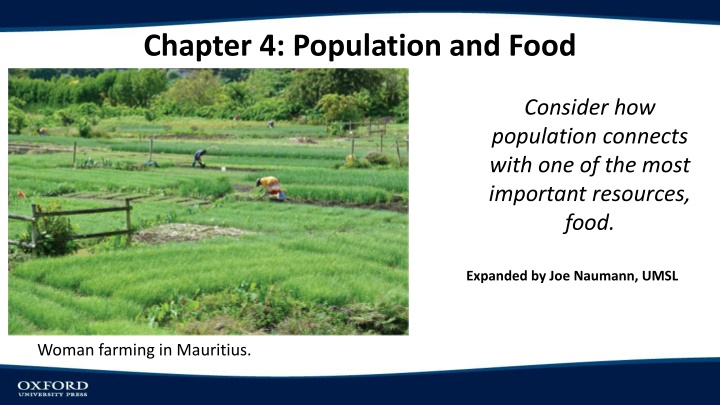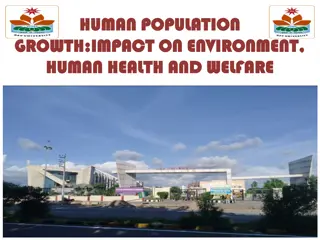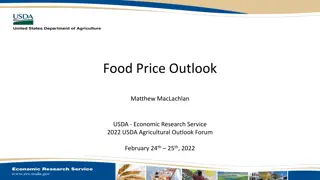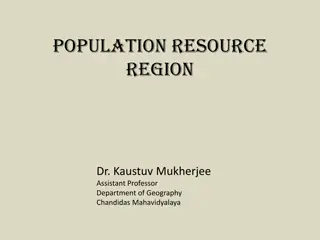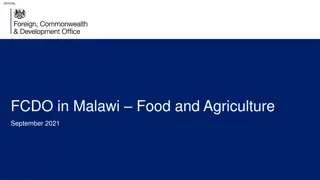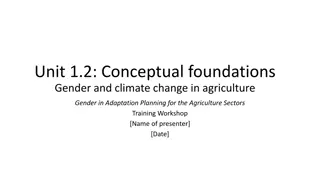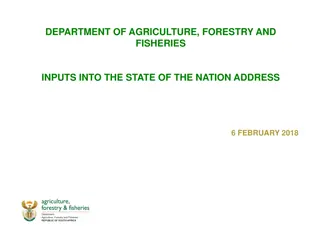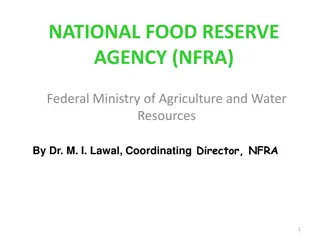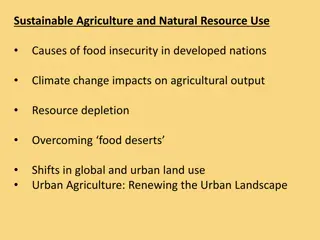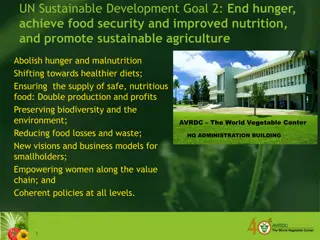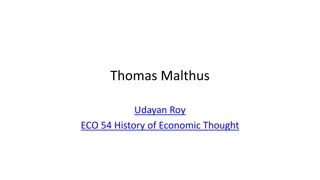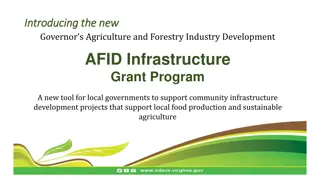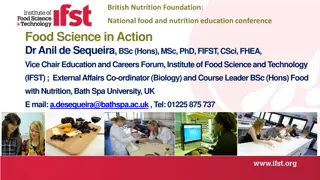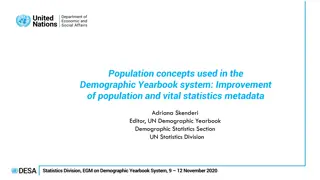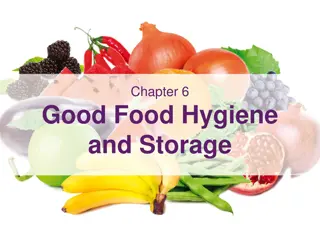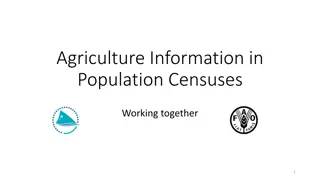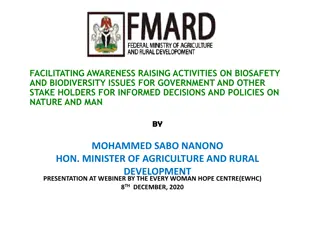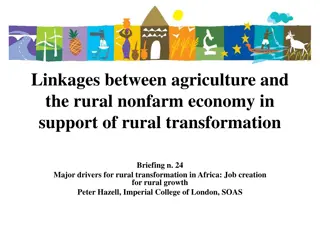Population, Food, and Agriculture: A Historical Perspective
Delve into the interconnected relationship between population growth, food production, and agriculture throughout history. Explore theories such as Malthusianism and Boserup's contributions, the evolution of food supply to meet global population demands, challenges in food security, and the impact of industrialized food systems on health and the environment. Reflect on the limits of agricultural production and the uneven distribution of food resources globally.
Download Presentation

Please find below an Image/Link to download the presentation.
The content on the website is provided AS IS for your information and personal use only. It may not be sold, licensed, or shared on other websites without obtaining consent from the author.If you encounter any issues during the download, it is possible that the publisher has removed the file from their server.
You are allowed to download the files provided on this website for personal or commercial use, subject to the condition that they are used lawfully. All files are the property of their respective owners.
The content on the website is provided AS IS for your information and personal use only. It may not be sold, licensed, or shared on other websites without obtaining consent from the author.
E N D
Presentation Transcript
Chapter 4: Population and Food Consider how population connects with one of the most important resources, food. Expanded by Joe Naumann, UMSL Woman farming in Mauritius.
Chapter Learning Objectives Explain the historical context of Malthus s theory. Understand Boserup s contribution. Summarize the ways that the global food supply has kept up with world population size. Discuss the lack of access to food, threats to food security, and limits to food production. Reflect on the corporate industrialized food production system and associated concerns over food quality, health, and the environment. Consider the unevenness of contemporary food production and consumption patterns.
Population and Agriculture Settled agriculture Increase in population beyond that of hunting- gathering societies Improvements in agricultural technology produced more food Rich, fertile soils and reliable source of water supported high densities of people Connection to growth of early civilizations Developed near sites of early plant and animal domestication Woman farming in Mauritius.
Domestication Sites On the next map, notice that the early cradles of civilization tended to develop in or very near centers of domestication 4
Cradles of Civilization Note the similarity with the previous map. 5
Malthusian Melancholy Historical context General argument Population increase at geometric rate, food supply at arithmetically Malthusian checks: misery, poverty, famine Social welfare stance Later applied to social Darwinism Food preparation and sale in Grenada.
Malthusian Melancholy Incorrect predictions Agricultural revolution and larger food supply base (vast arable lands of N. & S. America) Global population growth Ester Boserup Population will drive agricultural technology Population and food supply have increased Grocery store in Budapest, Hungary. Important fact: There are limits to how much agriculture can produce!
Malthusian Melancholy Evidence suggests further increases can meet further demands Variety of methods Closing the yield gap Further increasing production past Green Revolution increases Reducing waste Changing diets Expanding aquaculture Large commercial fishing boats in Gulf of Thailand. Most fishermen are indentured Burmese workers.
No More Virgin Lands The discovery of the New World postponed the consequences of Malthus conclusions. All the land is under cultivation now. 9
Negative factors to consider As urban areas expand around the world, they usually remove land from agricultural production. Poor land management plus climatic factors Desertification of semiarid grasslands Grassification of tropical rain forests Salinization of irrigated lands Loss of topsoil by wind and water erosion Acidification of oceans (from increased levels of CO2 in ocean) Bleaching of coral reefs & what kind of effect might it have on the phytoplankton (the base of the ocean food chain)
Overfishing Oceans as food source Industrial-style fishing is endangering supply Overfishing Wild fish supply peaked in 1980s Global fisheries decline Species extinction Growth of fish farming to replace wild losses Fisheries exploitation, 1950 and 2005.
Hunger, Famine, and Food Insecurity Food security Relatively easy access to safe and nutritious food Food insecure can be permanent or transitory Susceptibility to disease Famine Three causes: redirection of food; destruction of capacity to produce; and total neglect of starving Political factors of the Potato Blight Global Hunger Index. Shows the distribution of global hunger, notice the concentrations.
Food Deserts Producing enough food to feed all the people in the world does not mean that everyone will get a sufficient diet. In the US, obesity is a major health problem while in many developing nations, people are starving. Also, in spite of the abundance of ood produced in the US, there are people suffering from hunger. Variation in access Food deserts have very limited access to cheap, nutritious food Prevalence in low to median income areas and African American neighborhoods Correlates with lower rates of fresh food consumption and higher obesity rates
Limits to Food Supply Precarious balance Gains to be made, but systemic problems Declining land and water availability Land deficit with increasing population Loss of irrigated land to salinization and erosion Future trends Declining insecurity or increasing costs Irrigation in Midwest United States.
Questioning the Food Production System Industrialized agricultural system Produce large quantities Questions of quality and nutritional content Obesity epidemic Rise of processed food and overweight adults Obesity defined by body mass index (BMI) High levels in affluent and middle-income countries Geographic distribution of obesity for women. Map is similar for men.
Questioning the Food Production System Roots of obesity More than just an individual choice Obesogenic spaces create higher risk Food movements and nutrition concerns Heavy use of corn syrup Heavy chemical usage with rise of corporate industrialized food production system Overuse of salt in processed foods Low levels of protein in foods marketed toward children Geographic distribution of obesity for women. Map is similar for men.
Overpopulation Reexamined Paul Ehrlich s The Population Bomb Overpopulation and belief in population controls Critiques More than population Too many people in affluent countries with high ecological impact Politics of population control People are a resource The Population Bomb, published in 1968.
Subsistence and Commercial Agriculture Subsistence Traits Relies mostly on human labor little animal or machine power Low technology use Smaller average farm size Most food is consumed by farmer Commercial Traits Relies on capital investment in machinery, chemicals, improved seeds Large average farm size Products sold to agribusiness companies Fewer family owned farms 18
Types of Agriculture Defined by five variables Natural environment (sets initial parameters) Crops that are most productive in that environment Degree of technology used Market orientation Raised for human or animal consumption Human Raw material for industry Food Animal feed 20
Chapter Summary The agricultural revolution led to growth of human settlements. Malthus argued that population growth outpaced increase in food supply. Led to development of programs to reduce and control populations. Boserup theorized that increased populations would be followed by an increase in food production technologies that would enable larger populations to survive. Some researchers suggest it s possible to meet food demands by closing the yield gap, increasing production limits, reducing waste, changing diets, and expanding agriculture. Decline in hunger and malnutrition are result of agricultural production ability to surpass Malthusian limits. Three causes of famine: redirection of food, destruction of productive capacity to grow food, and total neglect of those who are hungry.
Chapter Summary Despite agricultural productivity, there is disagreement over world s ability to sustain population growth, especially with decline of productive land, water resources, and fisheries. Further, climate change may negatively impact that ability. Even with more food available worldwide, quality of food and the environmental impacts of new food production technologies and processes are questionable. One problem is processed food associated with greater rates of obesity found around the world, especially affluent and middle-income countries. Food movements emerge to call attention to concerns over quality of food, environmental impacts of producing foods, sustainability of food sources, and access of nutritious food to different communities.
Chapter Summary The idea of overpopulation is a politically charged debate that often ignores the greater environmental impact of more affluent populations. So it is not just a case that there are too many people; rather, too many of them have a heavy ecological footprint, which can only be solved when understanding the influence of politics as well as the opportunity that humans are a potential resource for talent, creativity, and creation of solutions. Although the basic food-supply limits first proposed by Malthus may no longer apply, out of 7.5 billion people, 1 billion remain hungry, 800 million malnourished, and another 1 billion are obese, confirming that there are still food-related concerns far beyond what Malthus or other early researchers may have considered.
